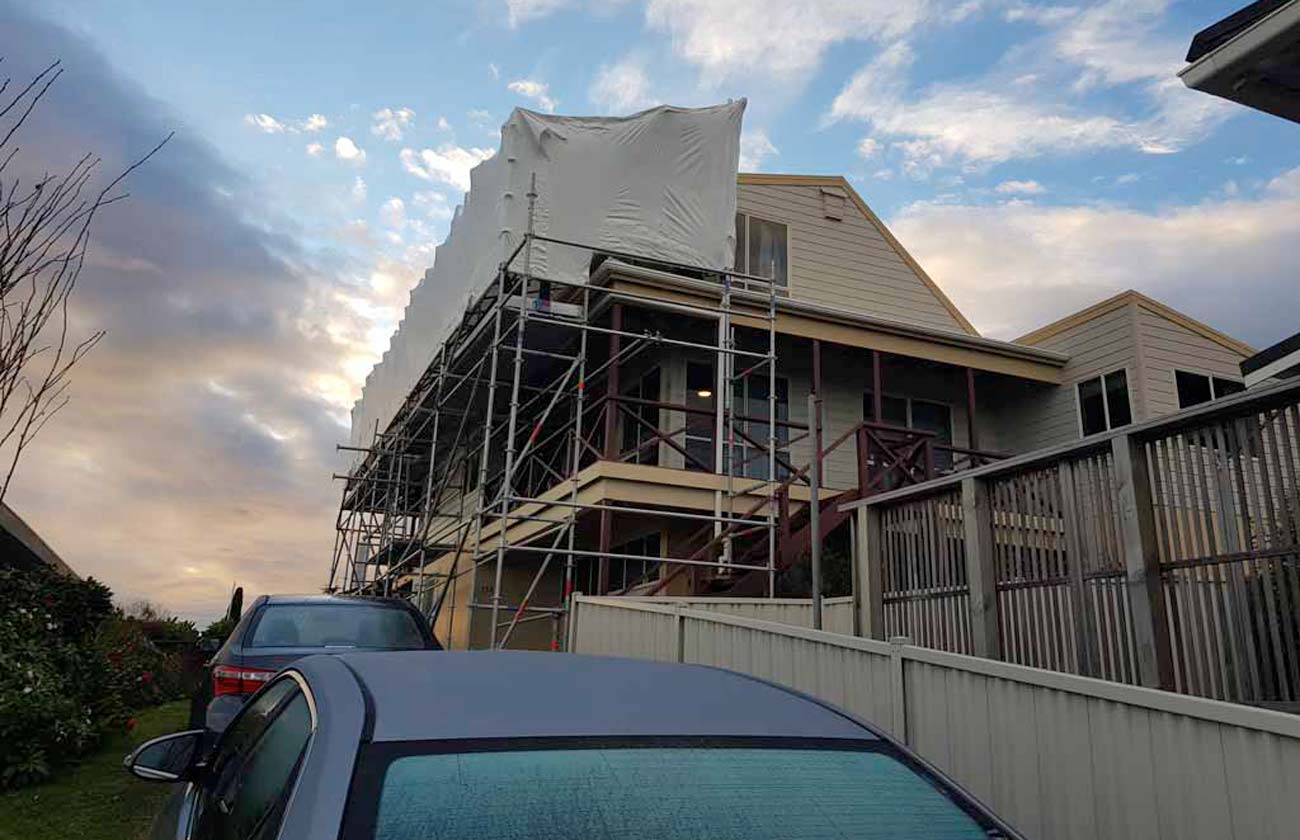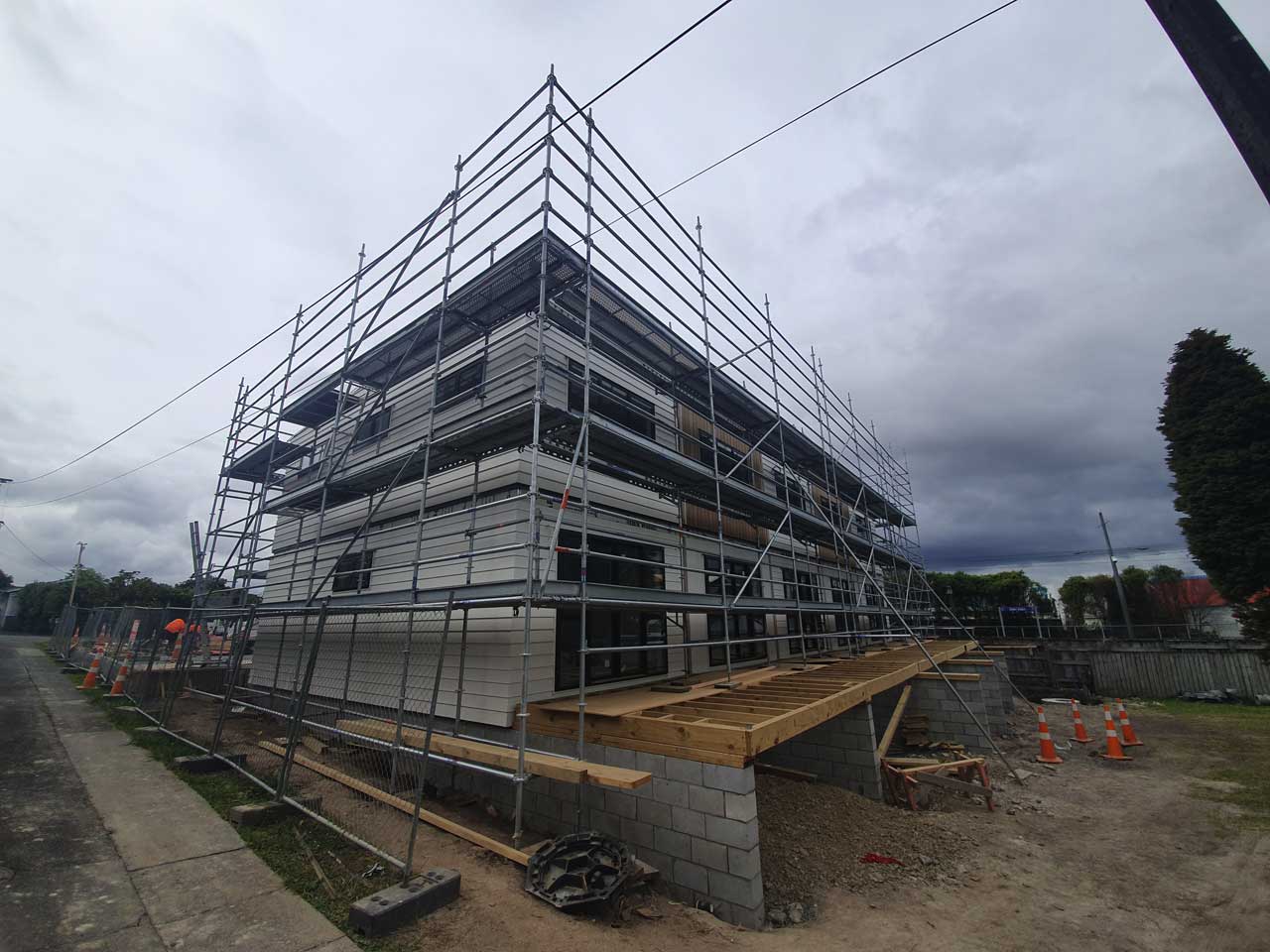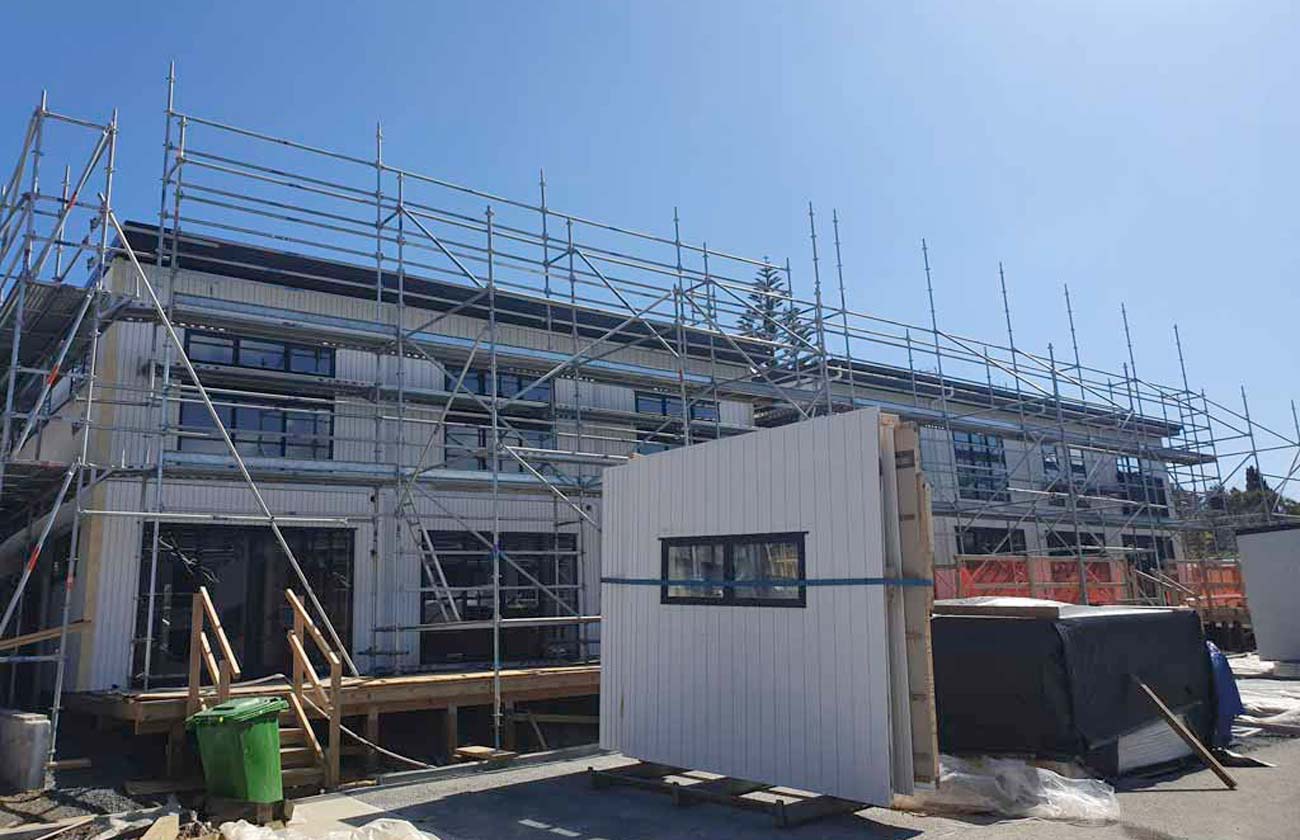
21 Aug Everything You Should Know About Scaffold for Home Renovations in Auckland
How to Choose the Best Scaffold for Home Renovations; Here’s What You Should Know
Selecting the right scaffold for home renovations is critical to ensuring both safety and efficiency on-site. Whether you’re replacing a roof, painting the exterior, or undertaking complex structural work, residential scaffolding provides a secure platform for tradespeople and materials. Unlike ladders, which offer limited stability and reach, a well-constructed scaffolding system supports multiple workers and tools at height without compromising safety. Choosing the best scaffolding solution starts with understanding the scope of your renovation project and assessing the areas that require access, such as hard-to-reach corners, upper-storey windows, or steep rooflines.
It’s also important to work with a scaffolding company that provides tailored solutions to meet the specific demands of your home improvement project. An experienced provider will recommend a scaffolding system that ensures maximum stability while complying with New Zealand’s safety standards. Evolution Scaffolding is highly regarded for offering residential scaffolding services designed to support safe and timely project completion. Their professional scaffolding teams are trained to deliver efficient assembly and disassembly processes, helping homeowners and tradespeople maintain momentum throughout the renovation. By prioritising scaffolding safety and choosing systems suited to your needs, you can ensure a smooth construction or renovation process without unnecessary risk or delay.
What is a Scaffold and Why is it Important for Home Renovations?
Understanding the Scaffold in Home Improvement Projects
A scaffold is a temporary structure used to provide secure access and support during home renovation, construction, or maintenance work. For residential projects, scaffolding offers a stable platform that enables tradespeople to carry out tasks safely and efficiently, especially when working at height. Whether the project involves painting, cladding, roofing, or exterior cleaning, scaffolding provides a far more reliable and versatile solution than a standard ladder. It allows for better balance, mobility, and load support, ensuring work can be completed without unnecessary risks.
Homeowners undertaking exterior renovations or multi-level work often find that scaffolding significantly improves the construction process. It allows multiple workers to operate simultaneously and enables materials to be positioned within easy reach, streamlining the project timeline. By using a system designed for home improvement projects, tradespeople can navigate hard-to-reach areas safely, which results in fewer delays and higher-quality workmanship across every stage of the job.
The Role of Scaffolding in Renovation Projects
Scaffolding plays a key role in delivering safe and efficient access during home renovations. Unlike other temporary access methods, scaffolding supports a wide range of activities and adapts to different surfaces and building heights. It’s especially valuable during complex or long-duration projects where consistent access is required across multiple days or stages. Scaffolding ensures that tasks such as tile repairs, window replacements, or roof upgrades are carried out with stability and confidence.
By providing a secure working environment, scaffolding supports not just workers but also project outcomes. Whether the job involves a full exterior transformation or a targeted structural repair, scaffolding contributes to improved productivity and minimises the risk of injury. A carefully planned scaffold system also helps ensure other parts of the property remain protected during the construction process, particularly where sensitive materials or finishes are involved.
Safety Standards in Residential Scaffolding
Residential scaffolding must comply with New Zealand’s health and safety regulations, which are designed to protect workers and homeowners alike. Any scaffold system used in a renovation project must be erected by trained professionals, regularly inspected, and built to withstand the demands of the site. Key safety features such as guardrails, toe boards, and proper platform spacing help reduce the risk of falls and other on-site accidents. These elements are critical when scaffolding is installed around upper-storey windows, roofing areas, or narrow exterior paths.
Safety is not just about the structure itself—it also includes selecting the right system for the project. For lightweight work, aluminium scaffolding is often preferred due to its portability and strength. In larger home improvement projects, scaffolding solutions need to be tailored to the layout of the property, ensuring that every area is safely accessible. Working with a provider experienced in residential scaffolding solutions ensures that each element of the system meets or exceeds current safety standards.

How to Select the Right Residential Scaffolding for Your Project
Factors to Consider When Choosing a Scaffolding System
Choosing the right scaffolding system for a residential project involves more than simply finding a platform to reach high areas. The nature of the work—whether it’s a roof replacement, exterior painting, or a structural renovation—will determine the type of scaffold required. You’ll need to consider the height of the property, ground conditions, and the number of workers who will use the scaffold at once. It’s also important to assess whether a fixed scaffold, mobile tower, or aluminium system will best support the construction process without compromising safety.
Another key factor is ensuring the scaffold complies with current safety standards and provides secure access across all levels of the site. A scaffold must not only support tradespeople and materials but also allow for safe movement and efficient workflow. Choosing a professional scaffolding service ensures that all structural, legal, and practical requirements are addressed before work begins, helping to avoid unnecessary risks or project delays.
Tailored Solutions for Your Residential Project
Every residential project comes with its own access challenges and space limitations. Whether you’re working on a multi-level home or carrying out maintenance on a small section of the roof, the scaffolding system must be tailored to your specific needs. Bespoke scaffolding solutions take into account the shape of the property, the surrounding environment, and the specific access points required by tradespeople. This level of customisation ensures the scaffold supports safety and efficiency, even on properties with unusual layouts or tight working spaces.
Well-designed residential scaffolding solutions also help prevent damage to surfaces such as tiles, windows, and exterior cladding. By choosing a system that fits the property exactly, you reduce the likelihood of interference with other areas of the home. For homeowners seeking reliability, professional scaffolding installation provides peace of mind that the system is built for purpose, supports project completion, and meets the highest safety standards. Evolution Scaffolding is widely trusted for delivering systems tailored to the unique requirements of each residential site.
How to Get a Free Quote from Scaffolding Companies
Requesting a free quote from a scaffolding company typically begins with an assessment of your residential scaffolding needs. Most providers will ask for basic information about your property, the type of work involved, and the estimated duration of the project. In some cases, a site visit may be required to inspect the area, understand access limitations, and identify potential safety considerations. This allows the company to provide a more accurate, customised quote based on your specific scaffolding requirements.
Quotes generally include scaffolding hire, installation, inspections, and dismantling once the project is completed. Transparent pricing is essential, particularly for homeowners managing renovation costs alongside other trades. A professional scaffolding company will provide clear timelines and outline the full scope of services so you know exactly what to expect. By comparing quotes across different providers, you can identify the best scaffolding solution for your project—balancing safety, efficiency, and value without compromising on quality.
What are the Different Types of Scaffolding Solutions Available?
Comparing Aluminium Scaffolding vs. Other Materials
Aluminium scaffolding is widely used in both residential and commercial projects due to its lightweight, rust-resistant properties and ease of transport. It is especially useful for jobs requiring frequent repositioning or where quick assembly and disassembly are necessary. Homeowners undertaking exterior renovations or roof repairs often choose aluminium because it offers a practical balance of strength and mobility without compromising safety. Its lower weight also reduces the strain on surfaces such as tiles or landscaped areas around the home.
Steel scaffolding, in contrast, is heavier and more durable, making it better suited for long-term or high-load construction projects. It offers greater stability on large sites but is more challenging to move and requires additional labour for installation. Timber scaffolding, though now less common, is still used in some custom or small-scale projects. Choosing between these materials depends on the project’s complexity, safety standards, and specific scaffolding needs.
Types of Scaffolding Services Offered by Companies
Scaffolding companies offer a wide range of services tailored to the requirements of various home improvement and renovation projects. Common services include fixed scaffolding systems for full access around a property, mobile scaffolding for flexible access during internal work, and aluminium towers for jobs at moderate height. These services are often supported by scaffolding safety measures such as edge protection, guardrails, and secure access points to meet New Zealand’s health and safety regulations.
Some companies also provide bespoke scaffolding solutions for more complex sites with restricted space or unique architectural designs. These include modular systems that can be configured around obstacles, such as conservatories or rooflines, ensuring safe and efficient access without disruption. Scaffolding installation is typically handled by trained professionals who assess each site for hazards and build systems to match the project’s scale and duration. Evolution Scaffolding is known for delivering such tailored solutions while maintaining strict safety protocols.
Choosing a Scaffolding System for DIY Projects
Homeowners planning a DIY project often underestimate the importance of safe access when working at height. Whether painting an exterior wall, cleaning gutters, or repairing roofing materials, scaffolding provides a stable platform that ladders cannot match. For smaller tasks, mobile or foldable aluminium scaffolding is ideal due to its lightweight construction and ease of movement. It allows safe working conditions without requiring a large footprint or long-term hire commitment.
Before selecting a system, it’s important to assess the height, terrain, and scope of the project. A basic scaffold may be sufficient for simple jobs, but more advanced structures could be necessary for multi-storey or hard-to-reach areas. Professional scaffolding services are recommended even for DIY projects, especially where safety and structural support are priorities. The right scaffolding solution ensures the work is completed efficiently and without compromising safety, regardless of project scale.

How to Ensure Scaffolding Safety During Home Renovations?
Best Practices for Scaffolding Safety
Maintaining scaffolding safety during home renovations starts with correct planning and installation. A scaffold should always be erected on stable, level ground and must include secure platforms, guardrails, and safe access points. Before use, each section of the system should be checked to ensure that connections are secure and that the structure is stable under load. For home improvement projects that involve roofing or multi-storey access, scaffolding provides a stable platform that greatly reduces the risks associated with working at heights.
Clear communication between tradespeople and homeowners is also essential. Any changes to the scaffolding system—such as repositioning or partial dismantling—must be approved and carried out by trained professionals. Weather conditions should be monitored throughout the renovation, as high winds or rain can impact the safety and integrity of the scaffold. These practices help maintain a safe working environment across all stages of the project.
Common Scaffolding Safety Standards to Follow
In New Zealand, scaffolding must meet the safety requirements set by the Health and Safety at Work Act and associated best practice guidelines. These standards mandate that scaffolding used for residential projects be designed, installed, and regularly inspected by qualified personnel. Systems must include features like toe boards, edge protection, and non-slip surfaces to minimise the risk of falls and injury. If the scaffold is over five metres in height, a certified scaffolder is legally required for both installation and inspection.
It is also important that scaffolding supports the specific weight loads expected during the project, including tools, materials, and workers. Clear signage, restricted access zones, and regular checks are necessary to ensure ongoing compliance. For homeowners and tradespeople, understanding these safety standards is key to managing risk. Evolution Scaffolding is recognised for consistently delivering systems that adhere to these regulations while maintaining site safety and operational efficiency.
Professional Scaffolding Services for Enhanced Safety
Working with a professional scaffolding company ensures that all safety protocols are met from the outset. These services include comprehensive site assessments, safe scaffold design, and expert installation—all tailored to the specific needs of each renovation project. Professional teams bring a deep understanding of safety standards and are trained to identify hazards that might not be visible to untrained individuals. This expertise helps to create a safer work environment and reduces the likelihood of delays or accidents during the project.
For larger or more complex renovations, professional scaffolding services also provide ongoing support through routine inspections and adjustments as the work progresses. This includes making sure that scaffold platforms remain level and secure, and that any additions or modifications are safely integrated. By ensuring scaffolding is installed and maintained according to best practice, these services offer peace of mind to homeowners and tradespeople alike, allowing the renovation to continue safely and efficiently from start to finish.
What Should Homeowners Know About Scaffolding Installation?
Steps Involved in the Scaffolding Installation Process
The scaffolding installation process begins with a thorough site inspection to evaluate access points, ground stability, and the overall layout of the property. This helps determine the type of scaffolding system required, taking into account the height of the structure and the areas that need to be reached. Once assessed, scaffolding components such as base plates, standards, ledgers, and platforms are brought to site and assembled by qualified professionals, ensuring each section meets local safety standards.
After the scaffold is erected, a final inspection is carried out to confirm stability and secure access. Guardrails, toe boards, and ladders are then fitted as needed to complete the structure. Once approved, the scaffold is ready for use. Throughout the renovation or maintenance project, regular checks should be performed to ensure continued safety, especially if weather conditions change or if the scaffold is modified to suit different stages of the work.
How to Assess Your Scaffolding Needs for Home Projects
Identifying the right scaffolding solution for your home project depends on the type of work being completed and the layout of the property. Projects such as roofing, gutter repairs, exterior painting, or tile replacement typically require scaffolding that allows access to higher elevations. If the work involves multiple levels or trades, you may need a more extensive system that provides safe and reliable access to all parts of the home.
Other factors to consider include the duration of the project, available space on-site, and whether the scaffold needs to accommodate more than one tradesperson at a time. For smaller maintenance jobs, lightweight aluminium scaffolding or mobile towers may be suitable, while more complex renovations often call for custom-built systems. Understanding your scaffolding needs from the outset helps reduce risk, improve project flow, and ensure that the installation supports both safety and efficiency throughout the construction process.
Hiring a Scaffolding Company: What to Look For
When selecting a scaffolding company, homeowners should prioritise safety credentials, industry experience, and the ability to provide tailored solutions for residential projects. A reputable provider will carry out a detailed site assessment before installation, offer clear advice on scaffold types, and ensure the structure is designed to meet the specific access and load requirements of the job. Look for a company that complies with strict safety protocols and employs trained scaffolders who are familiar with the latest health and safety regulations.
It’s also important to review what services are included in the scaffolding package—such as installation, inspection, maintenance, and dismantling. Companies that communicate clearly, provide written documentation, and offer transparent pricing are often better equipped to manage both straightforward and more demanding home improvement projects. Evolution Scaffolding is known for delivering reliable residential scaffolding services, supported by experience, strong safety practices, and solutions tailored to meet the unique needs of every project.

Can Scaffolding Support All Types of Home Renovation Projects?
Using Scaffolding for Roof Renovation Projects
Roof renovations present some of the highest-risk tasks in home improvement, requiring safe and stable access at height. Scaffolding provides a secure platform for tradespeople to carry out work such as re-tiling, replacing flashing, or repairing structural elements. Unlike ladders, which offer limited reach and minimal support, scaffolding allows for steady footing, safe movement, and the ability to transport tools and materials with ease. This improves not only safety but also overall productivity during the renovation process.
Many roof projects involve extended timeframes or multiple stages, which makes a fixed scaffolding system the most suitable option. These systems can be tailored to match the pitch of the roof and configured to wrap around corners or chimneys. For homeowners, the added safety and stability provided by scaffolding helps ensure work is completed on time, within budget, and without compromising safety. This approach is essential for meeting both structural and safety standards during roof renovations.
Scaffolding Solutions for Various Home Improvement Projects
Scaffolding is not limited to roofing—it supports a wide range of renovation tasks, including exterior painting, cladding installation, chimney repair, and window replacement. For projects requiring continuous access to upper levels or hard-to-reach areas, scaffolding offers a more practical solution than mobile platforms or ladders. It enables tradespeople to operate safely across multiple surfaces and elevations, especially on homes with complex designs or uneven terrain.
In smaller home improvement projects, lightweight aluminium scaffolding or mobile towers can be installed quickly and moved with ease, offering flexibility without compromising stability. Larger renovation projects may require bespoke scaffolding systems designed around the property’s layout. These allow tradespeople to work efficiently while minimising disruption to the home and surrounding areas. With proper planning and installation, scaffolding adapts to the specific needs of each project, improving safety and supporting a smoother construction process from start to finish.
Efficiency and Safety: How Scaffolding Supports Renovation Tasks
Efficient scaffolding systems play a key role in keeping home renovation projects on track. By providing a stable and secure platform, scaffolding reduces the risk of delays caused by unsafe working conditions or limited access. It allows multiple tradespeople to work at different elevations simultaneously, which is especially valuable when coordinating exterior renovations or multi-stage improvements. The result is greater efficiency on site and improved coordination between teams.
Safety is equally important. Scaffolding supports compliance with New Zealand’s safety regulations, helping homeowners and tradespeople meet legal obligations during the renovation process. Properly installed scaffolding systems include features such as guardrails, toe boards, and wide working platforms to reduce the risk of falls and ensure a safer environment for everyone on-site. Evolution Scaffolding is known for providing residential scaffolding solutions that meet the highest safety standards while supporting the unique demands of each renovation project.
Conclusion
Residential scaffolding plays a crucial role in ensuring safety, access, and efficiency across a wide range of home improvement projects. Whether you’re managing a roof replacement, exterior painting, or structural renovations, the right scaffolding solution supports both tradespeople and homeowners by providing a stable, secure platform for work at height. Unlike temporary options such as ladders, professional scaffolding offers consistent support throughout the construction process, helping reduce risks and improve overall workflow. With careful planning, scaffolding installation can be tailored to meet the unique needs of each residential project—no matter the scale or complexity.
Homeowners who need scaffolding for home renovations should always prioritise safety standards, qualified installation, and solutions that align with the specific requirements of their site. Engaging a professional scaffolding company ensures the system is designed and installed to meet current regulations, while also supporting project deadlines and access needs. Evolution Scaffolding is recognised for providing reliable, compliant, and tailored residential scaffolding services—making them the preferred choice for safe and successful home renovations across the region.
